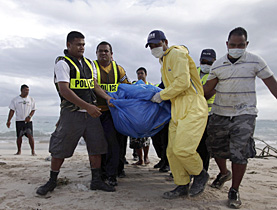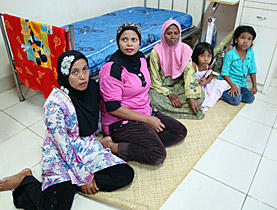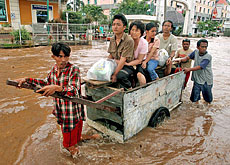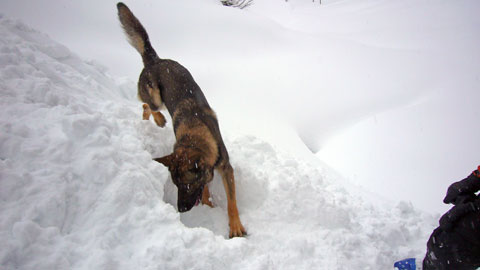Natural disasters leave Asia reeling

Rescue teams in Southeast Asia and the Pacific on Thursday struggled to deal with the devastation inflicted by four near-simultaneous natural disasters.
In Indonesia, emergency workers sought to find scores of people trapped under debris after a powerful earthquake hit the city of Padang, possibly killing thousands. Swiss rescue workers will join the effort on Friday.
The 7.6 magnitude quake on Wednesday originated in the sea off Sumatra island. It caused buildings to collapse and disrupted telephone service in the bustling port city of 900,000 people, just below the equator, killing at least 777 people. Many more are still missing.
A less powerful quake struck on Thursday.
Ten thousand kilometres east, stunned Samoans combed through soggy wreckage and told of the terror of being trapped underwater or flung inland by a tsunami that ravaged towns and killed at least 150 people.
Officials said they expected the death toll from Tuesday’s disaster to rise.
“The devastation caused was complete,” Samoan Prime Minister Tuilaepa Sailele said after inspecting the southeast coast of the main island of Upolu, the most heavily hit area.
“In some villages absolutely no house was standing. All that was achieved within ten minutes by the very powerful tsunami.”
The twin disasters were only half the story: coupled with the devastation from Typhoon Ketsana and torrential rains in the Philippines and Vietnam, the resources of local Red Cross and Red Crescent Societies have been stretched to their limits.
The Swiss foreign ministry said it had sent an advance team of seven experts to Sumatra on Thursday, while 120 rescue specialists from its Humanitarian Aid Unit would be deployed starting on Friday.
This is the first time in six years Switzerland has deployed its entire emergency disaster rescue team under a coordinated United Nations operation.
Juggling act
“It’s quite a juggling act,” said Patrick Fuller, a communications coordinator with the International Federation of Red Cross and Red Crescent Societies (IFRC) in Kuala Lumpur, Malaysia.
“The difficulty is the situation is still unclear in some of the outlying areas, where the epicentre of the quake was some way from Padang. Getting to this area is proving difficult. There are a lot of people on the road, there is a lot of panic,” he told swissinfo.ch in a telephone interview.
The IFRC on Thursday dispatched a helicopter to assess Sumatra’s remote areas. The group has also begun providing water, sanitation services and distributing relief supplies but says search and rescue remains the top priority.
“Usually it’s a week before they call off the rescue efforts in collapsed buildings,” Fuller said.
The IFRC has made investments in the last years to train local responders. “Our capacity is a lot stronger than it was as the Red Cross,” Fuller said. “At a governmental level, some of these countries have difficulty covering a lot of these emergency needs.”
In Indonesia, officials said heavy equipment such as bulldozers, excavators and concrete cutters were badly needed, although getting into the area would be difficult given many roads that were cut off.
The IFRC says it may now launch a big appeal for the country.
Indonesia, a poor, sprawling nation, sits on a major geological fault zone and is frequently hit by earthquakes. The latest quakes were along the same fault line that spawned the 2004 Asian tsunami that killed 230,000 people in a dozen countries.

More
International Federation of Red Cross and Red Crescent Societies
Better communication
The IFRC said that early warning systems saved thousands of lives this week.
“It is in these circumstances that investment in disaster preparedness and early warning pays off in real terms and lives are literally saved because of effective readiness,” said Michael Annear, the group’s disaster management coordinator for the Asia Pacific region.
The system nevertheless may need improvement. Before the Pacific Tsunami Warning Center in Hawaii issued its first alert, the Samoan tsunami was approaching the shore at the speed of a jet aircraft.
When the first warning came 18 minutes after Tuesday’s quake, waves between four and six metres high had already hit, washing away people and houses up to 1.5 kilometres inland.
The education of people in the Pacific, the world’s most active tsunami region, needs to start in schools, where they should be taught to flee automatically, said Kevin McCue, president of the Australian Earthquake Engineering Society.
Samoa had begun that process, with people learning the lessons of 2004 and running tsunami evacuation drills, as well as running a mobile phone system of texted alerts and relying on more basic methods.
swissinfo.ch and agencies
Swiss Solidarity, a non-profit organisation that funds humanitarian campaigns, has launched an appeal for earthquake victims in Sumatra.
The group and its partner relief organisations have made SFr300,000 available to transport emergency supplies from Jakarta.
Donations can be made onlineExternal link or by international bank transferExternal link.
Swiss Solidarity is the fundraising arm of the Swiss Broadcasting Corporation, swissinfo.ch’s parent company.
Padong is a port city of 900,000 people and the capital of West Sumatra province. Two strong earthquakes there in March 2007 killed at least 72 people.
Sumatra is the world’s fifth-biggest island with a population of about 48 million and covering an area of 470,000 sq km. It is a significant source of rubber, palm oil, timber, coffee and other agricultural commodities, as well as coal, oil, natural gas, tin and other minerals.
Sumatra lies along the so-called Pacific “Ring of Fire” of major seismic and volcanic activity and one of the world’s most active fault lines. Geologists have long warned Padang may one day be destroyed by a huge earthquake because of its location.
Aceh province on Sumatra’s northern tip was hardest hit by the 2004 tsunami that killed 230,000 people in the Indian Ocean area.
Poor infrastructure, incomplete warning systems and often shoddy construction in Sumatra mean seismic and volcanic events there frequently cause more deaths and damage than the equivalents in strength in more developed countries such as Japan.
A tsunami – from the Japanese “tsu” (harbour) and “nami” (wave) – is a fast travelling wave typically generated by vertical movements like a powerful, sub-sea earthquake.
Waves can travel at speeds of 800-1,000 km per hour. The height of normal waves and tsunami waves is similar in deep ocean water, but near shore, tsunami waves slow and swell, reaching heights of ten metres or more.
Normal ocean waves only involve motion of the uppermost layer of the water, but tsunami waves involve movement of the entire water column from surface to sea floor.
A tsunami is often wrongly described as a tidal wave. Although a tsunami’s impact can be influenced by tidal levels, tsunamis are unrelated to tides.
Major tsunamis occur about once a decade. About 59% of the world’s tsunamis have occurred in the Pacific Ocean, 25% in the Mediterranean Sea, 12% in the Atlantic Ocean and 4% in the Indian Ocean.

In compliance with the JTI standards
More: SWI swissinfo.ch certified by the Journalism Trust Initiative



You can find an overview of ongoing debates with our journalists here . Please join us!
If you want to start a conversation about a topic raised in this article or want to report factual errors, email us at english@swissinfo.ch.